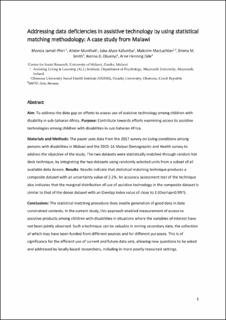| dc.contributor.author | Jamali-Phiri, Monica | |
| dc.contributor.author | Kafumba, Juba Alyce | |
| dc.contributor.author | MacLachlan, Mac | |
| dc.contributor.author | Smith, Emma | |
| dc.contributor.author | Ebuenyi, Ikenna | |
| dc.contributor.author | Eide, Arne Henning | |
| dc.contributor.author | Munthali, Alister | |
| dc.date.accessioned | 2023-03-09T12:50:31Z | |
| dc.date.available | 2023-03-09T12:50:31Z | |
| dc.date.created | 2021-01-11T14:05:14Z | |
| dc.date.issued | 2020 | |
| dc.identifier.citation | Disability and Rehabilitation: Assistive Technology. 2020. | en_US |
| dc.identifier.issn | 1748-3107 | |
| dc.identifier.uri | https://hdl.handle.net/11250/3057386 | |
| dc.description.abstract | Purpose: To address the data gap on efforts to assess use of assistive technology among children with disability in sub-Saharan Africa. Contribute towards efforts examining access to assistive technologies in sub-Saharan Africa.
Materials and methods: The paper uses data from the 2017 survey on Living conditions among persons with disabilities in Malawi and the 2015-16 Malawi Demographic and Health survey to address the objective of the study. The two datasets were statistically matched through random hot deck technique, by integrating the two datasets using randomly selected units from a subset of all available data donors.
Results: Results indicate that statistical matching technique produces a composite dataset with an uncertainty value of 2.2%. An accuracy assessment test of the technique also indicates that the marginal distribution of use of assistive technology in the composite dataset is similar to that of the donor dataset with an Overlap index value of close to 1 (Overlap = 0.997).
Conclusions: The statistical matching procedure does enable generation of good data in data constrained contexts. In the current study, this approach enabled measurement of access to assistive products among children with disabilities, in situations where the variables of interest have not been jointly observed. Such a technique can be valuable in mining secondary data, the collection of which may have been funded from different sources and for different purposes. This is of significance for the efficient use of current and future data sets, allowing new questions to be asked and addressed by locally based researchers in poor settings. | en_US |
| dc.language.iso | eng | en_US |
| dc.publisher | Taylor & Francis | en_US |
| dc.title | Addressing data deficiencies in assistive technology by using statistical matching methodology: a case study from Malawi, Disability and Rehabilitation: Assistive Technology | en_US |
| dc.type | Peer reviewed | en_US |
| dc.type | Journal article | en_US |
| dc.description.version | acceptedVersion | en_US |
| dc.source.journal | Disability and Rehabilitation: Assistive Technology | en_US |
| dc.identifier.doi | 10.1080/17483107.2020.1861118 | |
| dc.identifier.cristin | 1869063 | |
| cristin.ispublished | true | |
| cristin.fulltext | postprint | |
| cristin.qualitycode | 1 | |
